Developing a Positive Workplace Culture, Team Engagement and Maintaining Stakeholder Relationship
VerifiedAdded on 2023/05/30
|12
|4498
|443
AI Summary
The following narrative discusses the details of having a positive workforce culture, team engagement and stakeholder relationship. Developing a positive culture in the workforce, engaging team towards the company and maintaining relationships with stakeholders is an essential part of implementing a continuous business process that maintains the operational context of an organisation.
Contribute Materials
Your contribution can guide someone’s learning journey. Share your
documents today.
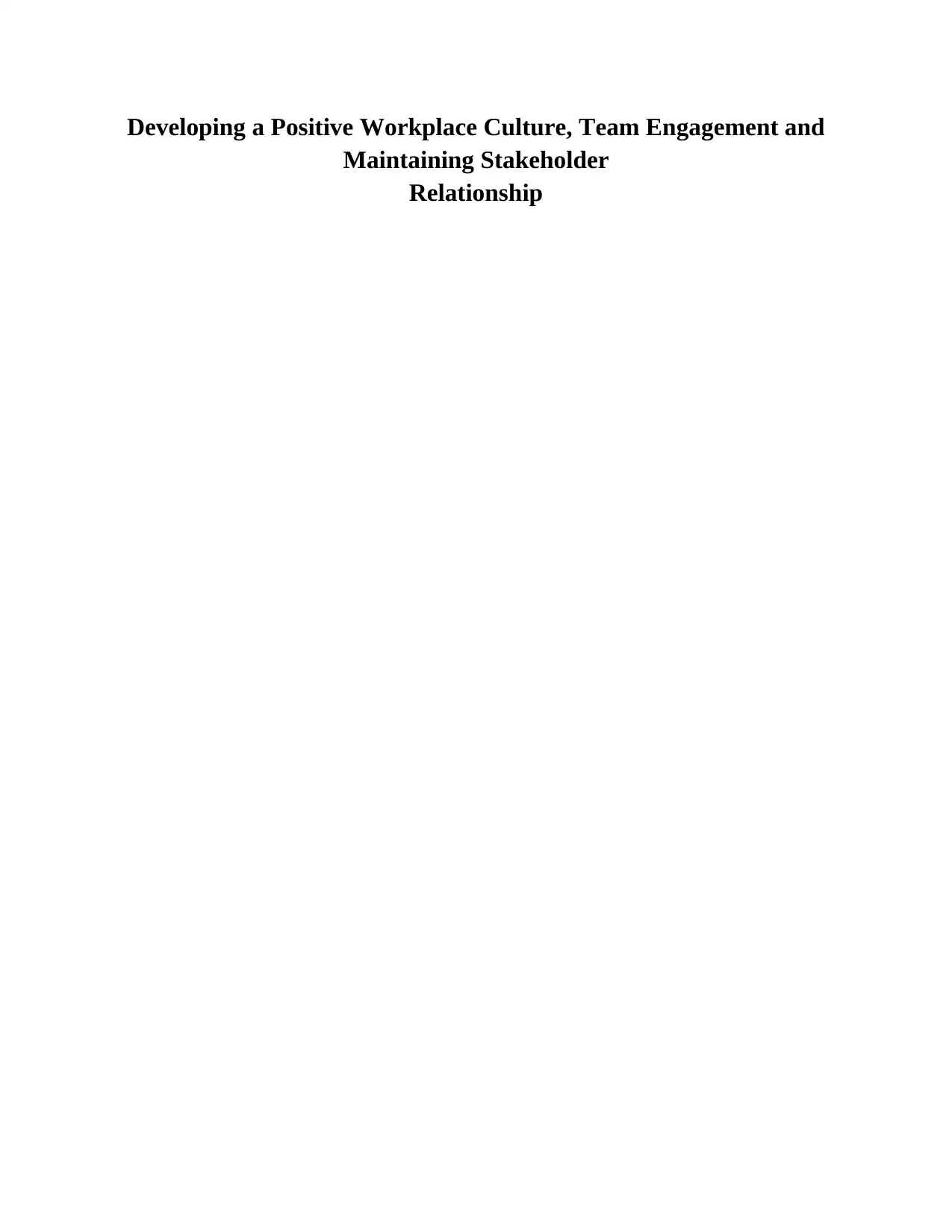
Developing a Positive Workplace Culture, Team Engagement and
Maintaining Stakeholder
Relationship
Maintaining Stakeholder
Relationship
Secure Best Marks with AI Grader
Need help grading? Try our AI Grader for instant feedback on your assignments.

Executive summary
The following narrative discusses the details of having a positive workforce culture, team
engagement and stakeholder relationship. Developing a positive culture in the workforce,
engaging team towards the company and maintaining relationships with stakeholders is an
essential part of implementing a continuous business process that maintains the operational
context of an organisation. Culture can be defined as a particular set of beliefs and behaviours
that are characteristic to a particular, ethnic, social or age, group. Team engagement refers to a
workforce approach that provides the proper conditions for every member of an organisation to
work with full efficiency, everyday, with commitment towards the goals and values of the
organisation and motivation towards achieving organisational success thus enhancing a sense of
their own well being. Stakeholders are either individuals, groups or an organisation who are
affected by the actions of an organization. They hold interests in the success of the company as
they have stakes in the company. The purpose of this plan is to help Unison Industry to develop
and maintain organisational integrity while the company implements continuous improvement
processes within the section of the company that is operational
The following narrative discusses the details of having a positive workforce culture, team
engagement and stakeholder relationship. Developing a positive culture in the workforce,
engaging team towards the company and maintaining relationships with stakeholders is an
essential part of implementing a continuous business process that maintains the operational
context of an organisation. Culture can be defined as a particular set of beliefs and behaviours
that are characteristic to a particular, ethnic, social or age, group. Team engagement refers to a
workforce approach that provides the proper conditions for every member of an organisation to
work with full efficiency, everyday, with commitment towards the goals and values of the
organisation and motivation towards achieving organisational success thus enhancing a sense of
their own well being. Stakeholders are either individuals, groups or an organisation who are
affected by the actions of an organization. They hold interests in the success of the company as
they have stakes in the company. The purpose of this plan is to help Unison Industry to develop
and maintain organisational integrity while the company implements continuous improvement
processes within the section of the company that is operational

Table of Contents
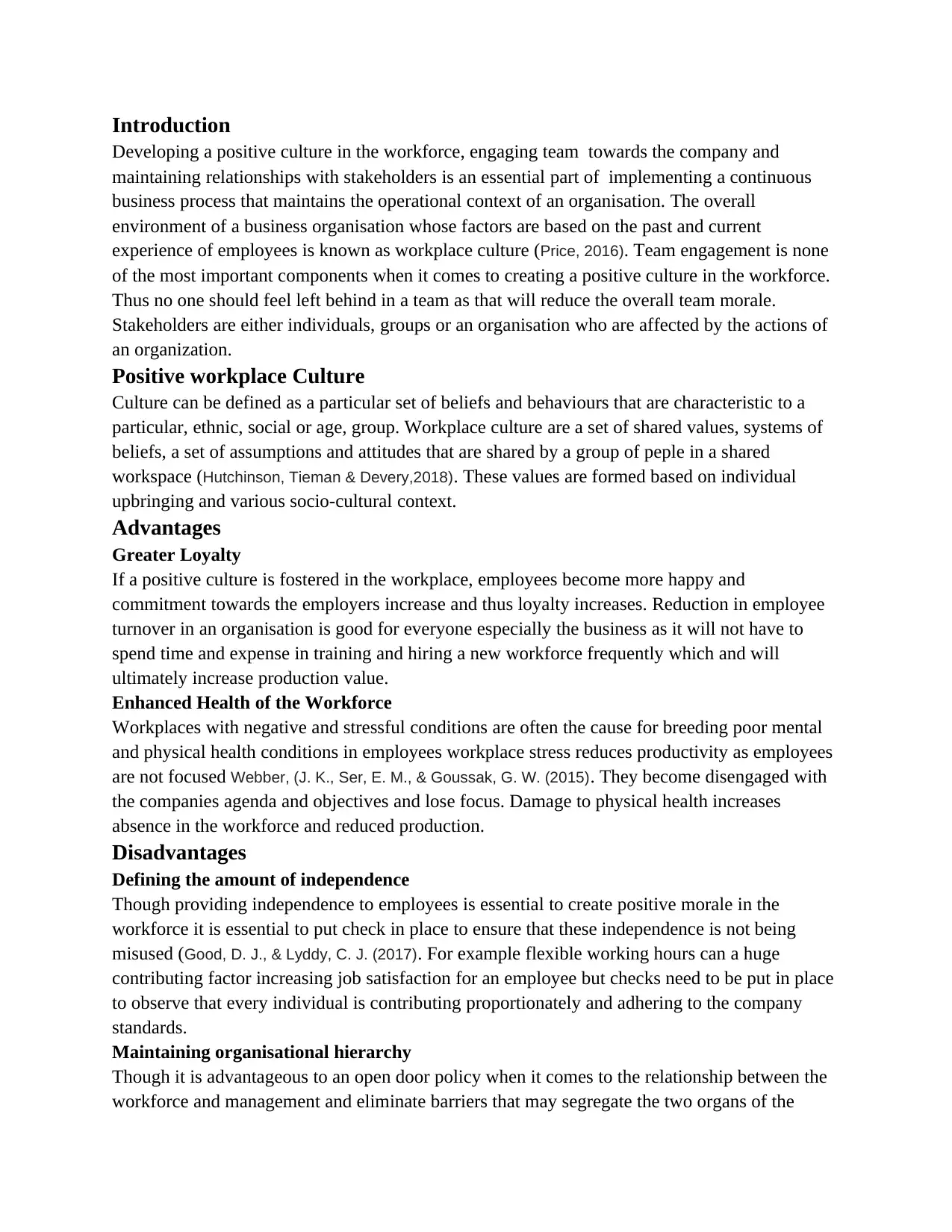
Introduction
Developing a positive culture in the workforce, engaging team towards the company and
maintaining relationships with stakeholders is an essential part of implementing a continuous
business process that maintains the operational context of an organisation. The overall
environment of a business organisation whose factors are based on the past and current
experience of employees is known as workplace culture (Price, 2016). Team engagement is none
of the most important components when it comes to creating a positive culture in the workforce.
Thus no one should feel left behind in a team as that will reduce the overall team morale.
Stakeholders are either individuals, groups or an organisation who are affected by the actions of
an organization.
Positive workplace Culture
Culture can be defined as a particular set of beliefs and behaviours that are characteristic to a
particular, ethnic, social or age, group. Workplace culture are a set of shared values, systems of
beliefs, a set of assumptions and attitudes that are shared by a group of peple in a shared
workspace (Hutchinson, Tieman & Devery,2018). These values are formed based on individual
upbringing and various socio-cultural context.
Advantages
Greater Loyalty
If a positive culture is fostered in the workplace, employees become more happy and
commitment towards the employers increase and thus loyalty increases. Reduction in employee
turnover in an organisation is good for everyone especially the business as it will not have to
spend time and expense in training and hiring a new workforce frequently which and will
ultimately increase production value.
Enhanced Health of the Workforce
Workplaces with negative and stressful conditions are often the cause for breeding poor mental
and physical health conditions in employees workplace stress reduces productivity as employees
are not focused Webber, (J. K., Ser, E. M., & Goussak, G. W. (2015). They become disengaged with
the companies agenda and objectives and lose focus. Damage to physical health increases
absence in the workforce and reduced production.
Disadvantages
Defining the amount of independence
Though providing independence to employees is essential to create positive morale in the
workforce it is essential to put check in place to ensure that these independence is not being
misused (Good, D. J., & Lyddy, C. J. (2017). For example flexible working hours can a huge
contributing factor increasing job satisfaction for an employee but checks need to be put in place
to observe that every individual is contributing proportionately and adhering to the company
standards.
Maintaining organisational hierarchy
Though it is advantageous to an open door policy when it comes to the relationship between the
workforce and management and eliminate barriers that may segregate the two organs of the
Developing a positive culture in the workforce, engaging team towards the company and
maintaining relationships with stakeholders is an essential part of implementing a continuous
business process that maintains the operational context of an organisation. The overall
environment of a business organisation whose factors are based on the past and current
experience of employees is known as workplace culture (Price, 2016). Team engagement is none
of the most important components when it comes to creating a positive culture in the workforce.
Thus no one should feel left behind in a team as that will reduce the overall team morale.
Stakeholders are either individuals, groups or an organisation who are affected by the actions of
an organization.
Positive workplace Culture
Culture can be defined as a particular set of beliefs and behaviours that are characteristic to a
particular, ethnic, social or age, group. Workplace culture are a set of shared values, systems of
beliefs, a set of assumptions and attitudes that are shared by a group of peple in a shared
workspace (Hutchinson, Tieman & Devery,2018). These values are formed based on individual
upbringing and various socio-cultural context.
Advantages
Greater Loyalty
If a positive culture is fostered in the workplace, employees become more happy and
commitment towards the employers increase and thus loyalty increases. Reduction in employee
turnover in an organisation is good for everyone especially the business as it will not have to
spend time and expense in training and hiring a new workforce frequently which and will
ultimately increase production value.
Enhanced Health of the Workforce
Workplaces with negative and stressful conditions are often the cause for breeding poor mental
and physical health conditions in employees workplace stress reduces productivity as employees
are not focused Webber, (J. K., Ser, E. M., & Goussak, G. W. (2015). They become disengaged with
the companies agenda and objectives and lose focus. Damage to physical health increases
absence in the workforce and reduced production.
Disadvantages
Defining the amount of independence
Though providing independence to employees is essential to create positive morale in the
workforce it is essential to put check in place to ensure that these independence is not being
misused (Good, D. J., & Lyddy, C. J. (2017). For example flexible working hours can a huge
contributing factor increasing job satisfaction for an employee but checks need to be put in place
to observe that every individual is contributing proportionately and adhering to the company
standards.
Maintaining organisational hierarchy
Though it is advantageous to an open door policy when it comes to the relationship between the
workforce and management and eliminate barriers that may segregate the two organs of the
Secure Best Marks with AI Grader
Need help grading? Try our AI Grader for instant feedback on your assignments.
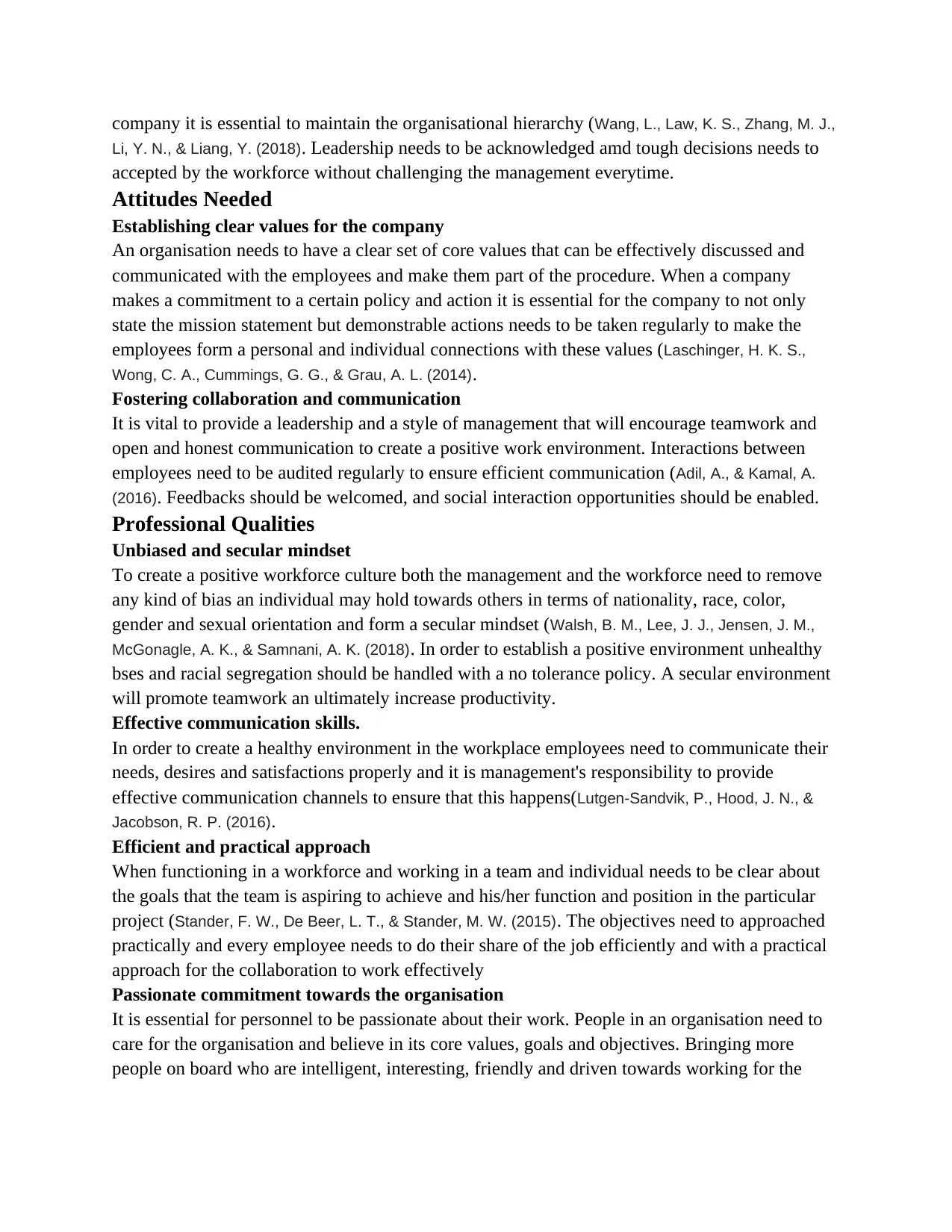
company it is essential to maintain the organisational hierarchy (Wang, L., Law, K. S., Zhang, M. J.,
Li, Y. N., & Liang, Y. (2018). Leadership needs to be acknowledged amd tough decisions needs to
accepted by the workforce without challenging the management everytime.
Attitudes Needed
Establishing clear values for the company
An organisation needs to have a clear set of core values that can be effectively discussed and
communicated with the employees and make them part of the procedure. When a company
makes a commitment to a certain policy and action it is essential for the company to not only
state the mission statement but demonstrable actions needs to be taken regularly to make the
employees form a personal and individual connections with these values (Laschinger, H. K. S.,
Wong, C. A., Cummings, G. G., & Grau, A. L. (2014).
Fostering collaboration and communication
It is vital to provide a leadership and a style of management that will encourage teamwork and
open and honest communication to create a positive work environment. Interactions between
employees need to be audited regularly to ensure efficient communication (Adil, A., & Kamal, A.
(2016). Feedbacks should be welcomed, and social interaction opportunities should be enabled.
Professional Qualities
Unbiased and secular mindset
To create a positive workforce culture both the management and the workforce need to remove
any kind of bias an individual may hold towards others in terms of nationality, race, color,
gender and sexual orientation and form a secular mindset (Walsh, B. M., Lee, J. J., Jensen, J. M.,
McGonagle, A. K., & Samnani, A. K. (2018). In order to establish a positive environment unhealthy
bses and racial segregation should be handled with a no tolerance policy. A secular environment
will promote teamwork an ultimately increase productivity.
Effective communication skills.
In order to create a healthy environment in the workplace employees need to communicate their
needs, desires and satisfactions properly and it is management's responsibility to provide
effective communication channels to ensure that this happens(Lutgen-Sandvik, P., Hood, J. N., &
Jacobson, R. P. (2016).
Efficient and practical approach
When functioning in a workforce and working in a team and individual needs to be clear about
the goals that the team is aspiring to achieve and his/her function and position in the particular
project (Stander, F. W., De Beer, L. T., & Stander, M. W. (2015). The objectives need to approached
practically and every employee needs to do their share of the job efficiently and with a practical
approach for the collaboration to work effectively
Passionate commitment towards the organisation
It is essential for personnel to be passionate about their work. People in an organisation need to
care for the organisation and believe in its core values, goals and objectives. Bringing more
people on board who are intelligent, interesting, friendly and driven towards working for the
Li, Y. N., & Liang, Y. (2018). Leadership needs to be acknowledged amd tough decisions needs to
accepted by the workforce without challenging the management everytime.
Attitudes Needed
Establishing clear values for the company
An organisation needs to have a clear set of core values that can be effectively discussed and
communicated with the employees and make them part of the procedure. When a company
makes a commitment to a certain policy and action it is essential for the company to not only
state the mission statement but demonstrable actions needs to be taken regularly to make the
employees form a personal and individual connections with these values (Laschinger, H. K. S.,
Wong, C. A., Cummings, G. G., & Grau, A. L. (2014).
Fostering collaboration and communication
It is vital to provide a leadership and a style of management that will encourage teamwork and
open and honest communication to create a positive work environment. Interactions between
employees need to be audited regularly to ensure efficient communication (Adil, A., & Kamal, A.
(2016). Feedbacks should be welcomed, and social interaction opportunities should be enabled.
Professional Qualities
Unbiased and secular mindset
To create a positive workforce culture both the management and the workforce need to remove
any kind of bias an individual may hold towards others in terms of nationality, race, color,
gender and sexual orientation and form a secular mindset (Walsh, B. M., Lee, J. J., Jensen, J. M.,
McGonagle, A. K., & Samnani, A. K. (2018). In order to establish a positive environment unhealthy
bses and racial segregation should be handled with a no tolerance policy. A secular environment
will promote teamwork an ultimately increase productivity.
Effective communication skills.
In order to create a healthy environment in the workplace employees need to communicate their
needs, desires and satisfactions properly and it is management's responsibility to provide
effective communication channels to ensure that this happens(Lutgen-Sandvik, P., Hood, J. N., &
Jacobson, R. P. (2016).
Efficient and practical approach
When functioning in a workforce and working in a team and individual needs to be clear about
the goals that the team is aspiring to achieve and his/her function and position in the particular
project (Stander, F. W., De Beer, L. T., & Stander, M. W. (2015). The objectives need to approached
practically and every employee needs to do their share of the job efficiently and with a practical
approach for the collaboration to work effectively
Passionate commitment towards the organisation
It is essential for personnel to be passionate about their work. People in an organisation need to
care for the organisation and believe in its core values, goals and objectives. Bringing more
people on board who are intelligent, interesting, friendly and driven towards working for the
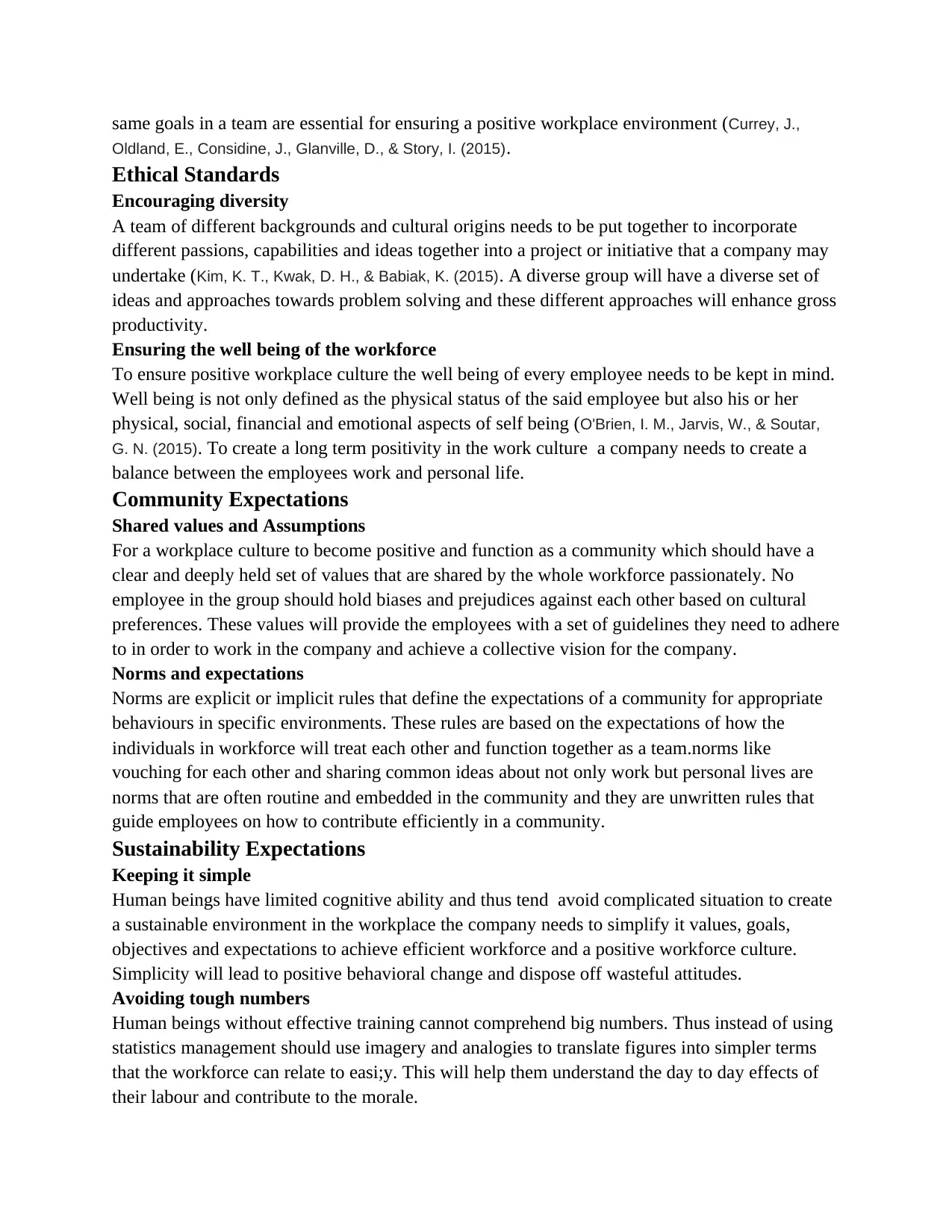
same goals in a team are essential for ensuring a positive workplace environment (Currey, J.,
Oldland, E., Considine, J., Glanville, D., & Story, I. (2015).
Ethical Standards
Encouraging diversity
A team of different backgrounds and cultural origins needs to be put together to incorporate
different passions, capabilities and ideas together into a project or initiative that a company may
undertake (Kim, K. T., Kwak, D. H., & Babiak, K. (2015). A diverse group will have a diverse set of
ideas and approaches towards problem solving and these different approaches will enhance gross
productivity.
Ensuring the well being of the workforce
To ensure positive workplace culture the well being of every employee needs to be kept in mind.
Well being is not only defined as the physical status of the said employee but also his or her
physical, social, financial and emotional aspects of self being (O'Brien, I. M., Jarvis, W., & Soutar,
G. N. (2015). To create a long term positivity in the work culture a company needs to create a
balance between the employees work and personal life.
Community Expectations
Shared values and Assumptions
For a workplace culture to become positive and function as a community which should have a
clear and deeply held set of values that are shared by the whole workforce passionately. No
employee in the group should hold biases and prejudices against each other based on cultural
preferences. These values will provide the employees with a set of guidelines they need to adhere
to in order to work in the company and achieve a collective vision for the company.
Norms and expectations
Norms are explicit or implicit rules that define the expectations of a community for appropriate
behaviours in specific environments. These rules are based on the expectations of how the
individuals in workforce will treat each other and function together as a team.norms like
vouching for each other and sharing common ideas about not only work but personal lives are
norms that are often routine and embedded in the community and they are unwritten rules that
guide employees on how to contribute efficiently in a community.
Sustainability Expectations
Keeping it simple
Human beings have limited cognitive ability and thus tend avoid complicated situation to create
a sustainable environment in the workplace the company needs to simplify it values, goals,
objectives and expectations to achieve efficient workforce and a positive workforce culture.
Simplicity will lead to positive behavioral change and dispose off wasteful attitudes.
Avoiding tough numbers
Human beings without effective training cannot comprehend big numbers. Thus instead of using
statistics management should use imagery and analogies to translate figures into simpler terms
that the workforce can relate to easi;y. This will help them understand the day to day effects of
their labour and contribute to the morale.
Oldland, E., Considine, J., Glanville, D., & Story, I. (2015).
Ethical Standards
Encouraging diversity
A team of different backgrounds and cultural origins needs to be put together to incorporate
different passions, capabilities and ideas together into a project or initiative that a company may
undertake (Kim, K. T., Kwak, D. H., & Babiak, K. (2015). A diverse group will have a diverse set of
ideas and approaches towards problem solving and these different approaches will enhance gross
productivity.
Ensuring the well being of the workforce
To ensure positive workplace culture the well being of every employee needs to be kept in mind.
Well being is not only defined as the physical status of the said employee but also his or her
physical, social, financial and emotional aspects of self being (O'Brien, I. M., Jarvis, W., & Soutar,
G. N. (2015). To create a long term positivity in the work culture a company needs to create a
balance between the employees work and personal life.
Community Expectations
Shared values and Assumptions
For a workplace culture to become positive and function as a community which should have a
clear and deeply held set of values that are shared by the whole workforce passionately. No
employee in the group should hold biases and prejudices against each other based on cultural
preferences. These values will provide the employees with a set of guidelines they need to adhere
to in order to work in the company and achieve a collective vision for the company.
Norms and expectations
Norms are explicit or implicit rules that define the expectations of a community for appropriate
behaviours in specific environments. These rules are based on the expectations of how the
individuals in workforce will treat each other and function together as a team.norms like
vouching for each other and sharing common ideas about not only work but personal lives are
norms that are often routine and embedded in the community and they are unwritten rules that
guide employees on how to contribute efficiently in a community.
Sustainability Expectations
Keeping it simple
Human beings have limited cognitive ability and thus tend avoid complicated situation to create
a sustainable environment in the workplace the company needs to simplify it values, goals,
objectives and expectations to achieve efficient workforce and a positive workforce culture.
Simplicity will lead to positive behavioral change and dispose off wasteful attitudes.
Avoiding tough numbers
Human beings without effective training cannot comprehend big numbers. Thus instead of using
statistics management should use imagery and analogies to translate figures into simpler terms
that the workforce can relate to easi;y. This will help them understand the day to day effects of
their labour and contribute to the morale.
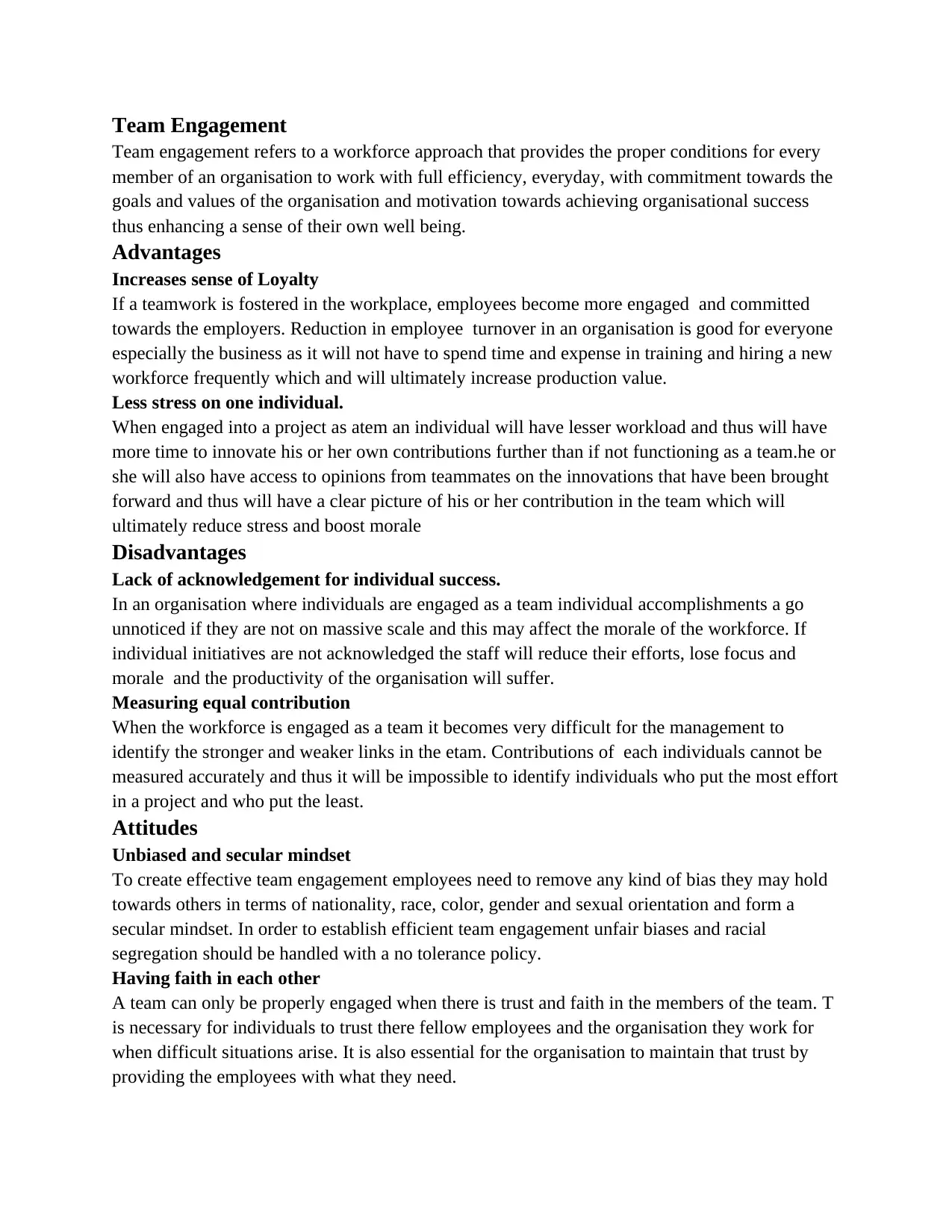
Team Engagement
Team engagement refers to a workforce approach that provides the proper conditions for every
member of an organisation to work with full efficiency, everyday, with commitment towards the
goals and values of the organisation and motivation towards achieving organisational success
thus enhancing a sense of their own well being.
Advantages
Increases sense of Loyalty
If a teamwork is fostered in the workplace, employees become more engaged and committed
towards the employers. Reduction in employee turnover in an organisation is good for everyone
especially the business as it will not have to spend time and expense in training and hiring a new
workforce frequently which and will ultimately increase production value.
Less stress on one individual.
When engaged into a project as atem an individual will have lesser workload and thus will have
more time to innovate his or her own contributions further than if not functioning as a team.he or
she will also have access to opinions from teammates on the innovations that have been brought
forward and thus will have a clear picture of his or her contribution in the team which will
ultimately reduce stress and boost morale
Disadvantages
Lack of acknowledgement for individual success.
In an organisation where individuals are engaged as a team individual accomplishments a go
unnoticed if they are not on massive scale and this may affect the morale of the workforce. If
individual initiatives are not acknowledged the staff will reduce their efforts, lose focus and
morale and the productivity of the organisation will suffer.
Measuring equal contribution
When the workforce is engaged as a team it becomes very difficult for the management to
identify the stronger and weaker links in the etam. Contributions of each individuals cannot be
measured accurately and thus it will be impossible to identify individuals who put the most effort
in a project and who put the least.
Attitudes
Unbiased and secular mindset
To create effective team engagement employees need to remove any kind of bias they may hold
towards others in terms of nationality, race, color, gender and sexual orientation and form a
secular mindset. In order to establish efficient team engagement unfair biases and racial
segregation should be handled with a no tolerance policy.
Having faith in each other
A team can only be properly engaged when there is trust and faith in the members of the team. T
is necessary for individuals to trust there fellow employees and the organisation they work for
when difficult situations arise. It is also essential for the organisation to maintain that trust by
providing the employees with what they need.
Team engagement refers to a workforce approach that provides the proper conditions for every
member of an organisation to work with full efficiency, everyday, with commitment towards the
goals and values of the organisation and motivation towards achieving organisational success
thus enhancing a sense of their own well being.
Advantages
Increases sense of Loyalty
If a teamwork is fostered in the workplace, employees become more engaged and committed
towards the employers. Reduction in employee turnover in an organisation is good for everyone
especially the business as it will not have to spend time and expense in training and hiring a new
workforce frequently which and will ultimately increase production value.
Less stress on one individual.
When engaged into a project as atem an individual will have lesser workload and thus will have
more time to innovate his or her own contributions further than if not functioning as a team.he or
she will also have access to opinions from teammates on the innovations that have been brought
forward and thus will have a clear picture of his or her contribution in the team which will
ultimately reduce stress and boost morale
Disadvantages
Lack of acknowledgement for individual success.
In an organisation where individuals are engaged as a team individual accomplishments a go
unnoticed if they are not on massive scale and this may affect the morale of the workforce. If
individual initiatives are not acknowledged the staff will reduce their efforts, lose focus and
morale and the productivity of the organisation will suffer.
Measuring equal contribution
When the workforce is engaged as a team it becomes very difficult for the management to
identify the stronger and weaker links in the etam. Contributions of each individuals cannot be
measured accurately and thus it will be impossible to identify individuals who put the most effort
in a project and who put the least.
Attitudes
Unbiased and secular mindset
To create effective team engagement employees need to remove any kind of bias they may hold
towards others in terms of nationality, race, color, gender and sexual orientation and form a
secular mindset. In order to establish efficient team engagement unfair biases and racial
segregation should be handled with a no tolerance policy.
Having faith in each other
A team can only be properly engaged when there is trust and faith in the members of the team. T
is necessary for individuals to trust there fellow employees and the organisation they work for
when difficult situations arise. It is also essential for the organisation to maintain that trust by
providing the employees with what they need.
Paraphrase This Document
Need a fresh take? Get an instant paraphrase of this document with our AI Paraphraser
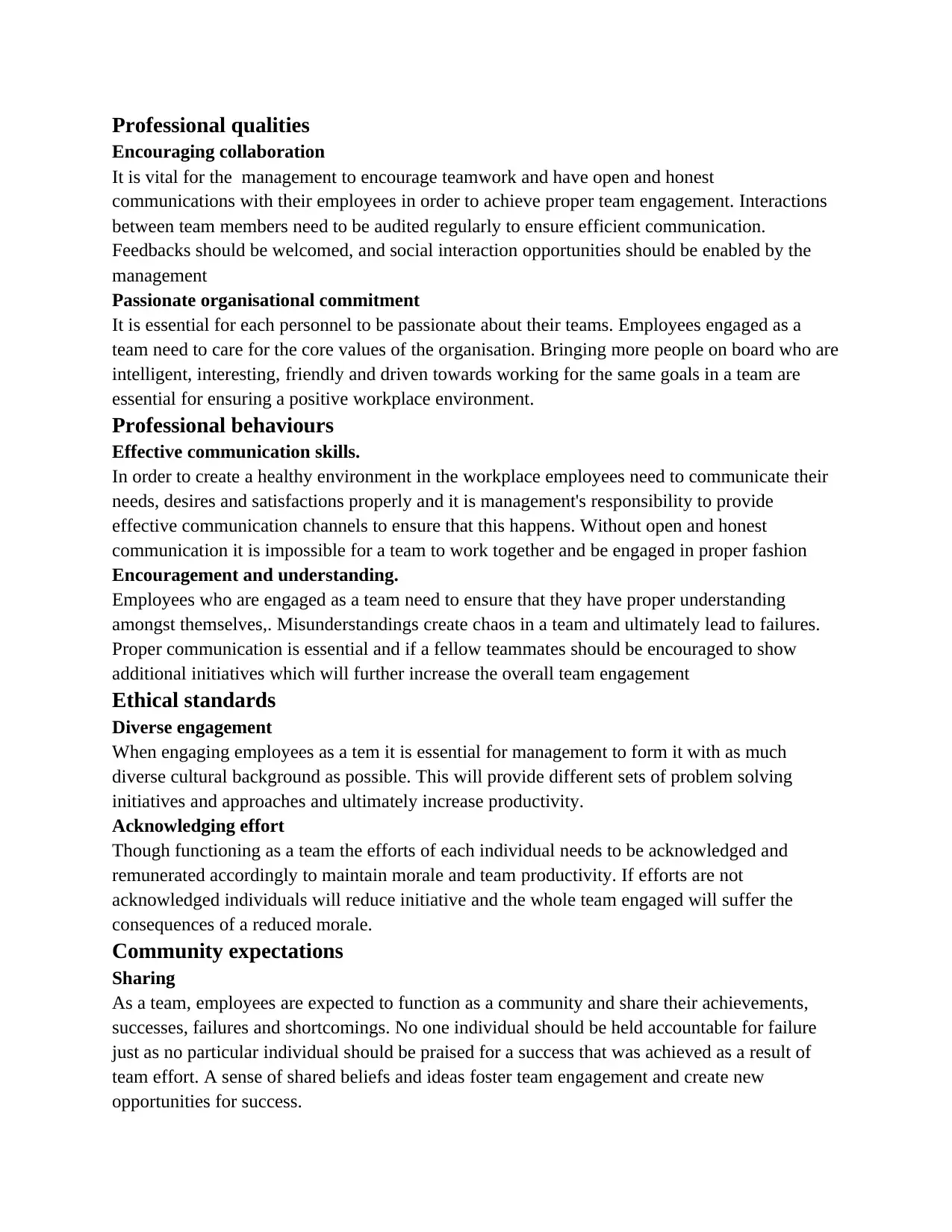
Professional qualities
Encouraging collaboration
It is vital for the management to encourage teamwork and have open and honest
communications with their employees in order to achieve proper team engagement. Interactions
between team members need to be audited regularly to ensure efficient communication.
Feedbacks should be welcomed, and social interaction opportunities should be enabled by the
management
Passionate organisational commitment
It is essential for each personnel to be passionate about their teams. Employees engaged as a
team need to care for the core values of the organisation. Bringing more people on board who are
intelligent, interesting, friendly and driven towards working for the same goals in a team are
essential for ensuring a positive workplace environment.
Professional behaviours
Effective communication skills.
In order to create a healthy environment in the workplace employees need to communicate their
needs, desires and satisfactions properly and it is management's responsibility to provide
effective communication channels to ensure that this happens. Without open and honest
communication it is impossible for a team to work together and be engaged in proper fashion
Encouragement and understanding.
Employees who are engaged as a team need to ensure that they have proper understanding
amongst themselves,. Misunderstandings create chaos in a team and ultimately lead to failures.
Proper communication is essential and if a fellow teammates should be encouraged to show
additional initiatives which will further increase the overall team engagement
Ethical standards
Diverse engagement
When engaging employees as a tem it is essential for management to form it with as much
diverse cultural background as possible. This will provide different sets of problem solving
initiatives and approaches and ultimately increase productivity.
Acknowledging effort
Though functioning as a team the efforts of each individual needs to be acknowledged and
remunerated accordingly to maintain morale and team productivity. If efforts are not
acknowledged individuals will reduce initiative and the whole team engaged will suffer the
consequences of a reduced morale.
Community expectations
Sharing
As a team, employees are expected to function as a community and share their achievements,
successes, failures and shortcomings. No one individual should be held accountable for failure
just as no particular individual should be praised for a success that was achieved as a result of
team effort. A sense of shared beliefs and ideas foster team engagement and create new
opportunities for success.
Encouraging collaboration
It is vital for the management to encourage teamwork and have open and honest
communications with their employees in order to achieve proper team engagement. Interactions
between team members need to be audited regularly to ensure efficient communication.
Feedbacks should be welcomed, and social interaction opportunities should be enabled by the
management
Passionate organisational commitment
It is essential for each personnel to be passionate about their teams. Employees engaged as a
team need to care for the core values of the organisation. Bringing more people on board who are
intelligent, interesting, friendly and driven towards working for the same goals in a team are
essential for ensuring a positive workplace environment.
Professional behaviours
Effective communication skills.
In order to create a healthy environment in the workplace employees need to communicate their
needs, desires and satisfactions properly and it is management's responsibility to provide
effective communication channels to ensure that this happens. Without open and honest
communication it is impossible for a team to work together and be engaged in proper fashion
Encouragement and understanding.
Employees who are engaged as a team need to ensure that they have proper understanding
amongst themselves,. Misunderstandings create chaos in a team and ultimately lead to failures.
Proper communication is essential and if a fellow teammates should be encouraged to show
additional initiatives which will further increase the overall team engagement
Ethical standards
Diverse engagement
When engaging employees as a tem it is essential for management to form it with as much
diverse cultural background as possible. This will provide different sets of problem solving
initiatives and approaches and ultimately increase productivity.
Acknowledging effort
Though functioning as a team the efforts of each individual needs to be acknowledged and
remunerated accordingly to maintain morale and team productivity. If efforts are not
acknowledged individuals will reduce initiative and the whole team engaged will suffer the
consequences of a reduced morale.
Community expectations
Sharing
As a team, employees are expected to function as a community and share their achievements,
successes, failures and shortcomings. No one individual should be held accountable for failure
just as no particular individual should be praised for a success that was achieved as a result of
team effort. A sense of shared beliefs and ideas foster team engagement and create new
opportunities for success.
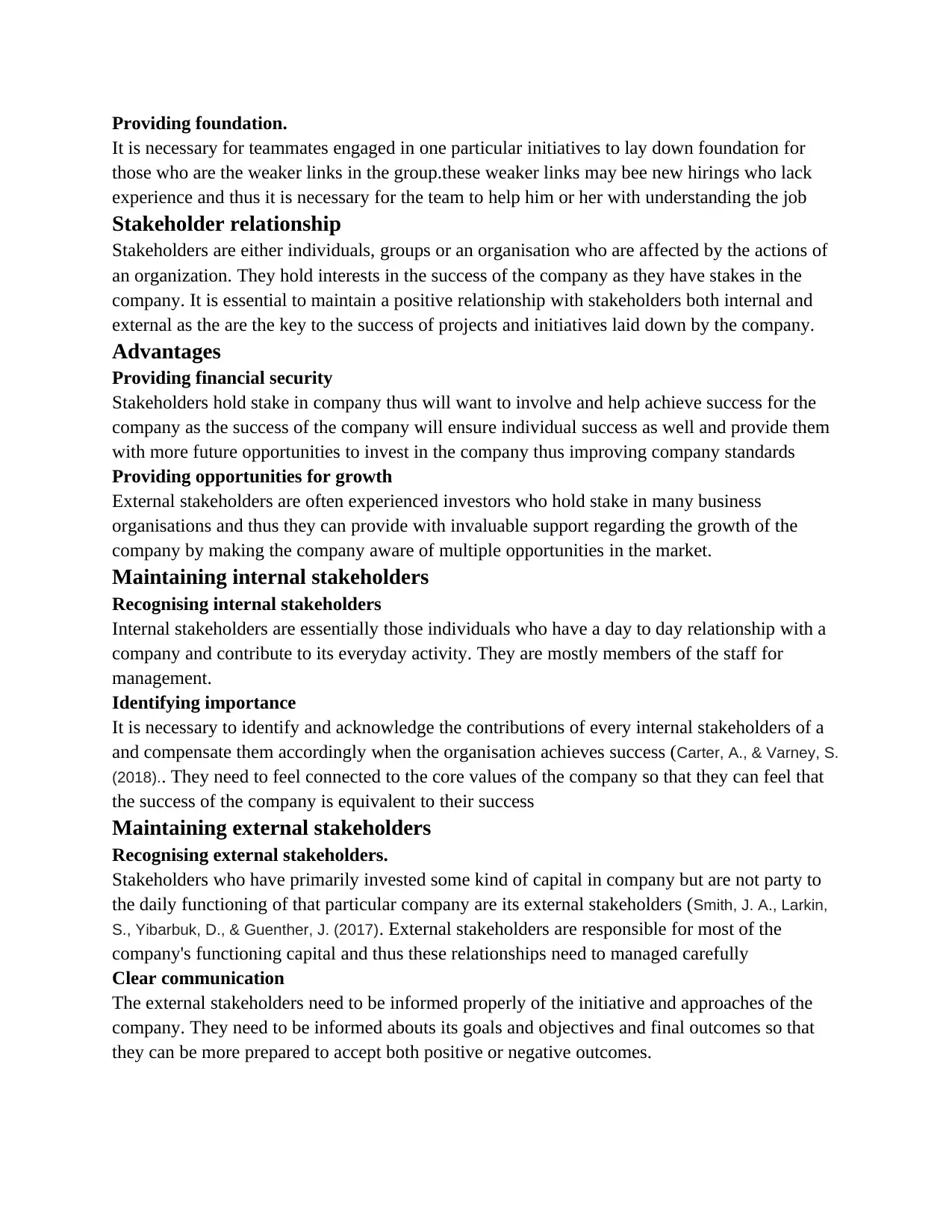
Providing foundation.
It is necessary for teammates engaged in one particular initiatives to lay down foundation for
those who are the weaker links in the group.these weaker links may bee new hirings who lack
experience and thus it is necessary for the team to help him or her with understanding the job
Stakeholder relationship
Stakeholders are either individuals, groups or an organisation who are affected by the actions of
an organization. They hold interests in the success of the company as they have stakes in the
company. It is essential to maintain a positive relationship with stakeholders both internal and
external as the are the key to the success of projects and initiatives laid down by the company.
Advantages
Providing financial security
Stakeholders hold stake in company thus will want to involve and help achieve success for the
company as the success of the company will ensure individual success as well and provide them
with more future opportunities to invest in the company thus improving company standards
Providing opportunities for growth
External stakeholders are often experienced investors who hold stake in many business
organisations and thus they can provide with invaluable support regarding the growth of the
company by making the company aware of multiple opportunities in the market.
Maintaining internal stakeholders
Recognising internal stakeholders
Internal stakeholders are essentially those individuals who have a day to day relationship with a
company and contribute to its everyday activity. They are mostly members of the staff for
management.
Identifying importance
It is necessary to identify and acknowledge the contributions of every internal stakeholders of a
and compensate them accordingly when the organisation achieves success (Carter, A., & Varney, S.
(2018).. They need to feel connected to the core values of the company so that they can feel that
the success of the company is equivalent to their success
Maintaining external stakeholders
Recognising external stakeholders.
Stakeholders who have primarily invested some kind of capital in company but are not party to
the daily functioning of that particular company are its external stakeholders (Smith, J. A., Larkin,
S., Yibarbuk, D., & Guenther, J. (2017). External stakeholders are responsible for most of the
company's functioning capital and thus these relationships need to managed carefully
Clear communication
The external stakeholders need to be informed properly of the initiative and approaches of the
company. They need to be informed abouts its goals and objectives and final outcomes so that
they can be more prepared to accept both positive or negative outcomes.
It is necessary for teammates engaged in one particular initiatives to lay down foundation for
those who are the weaker links in the group.these weaker links may bee new hirings who lack
experience and thus it is necessary for the team to help him or her with understanding the job
Stakeholder relationship
Stakeholders are either individuals, groups or an organisation who are affected by the actions of
an organization. They hold interests in the success of the company as they have stakes in the
company. It is essential to maintain a positive relationship with stakeholders both internal and
external as the are the key to the success of projects and initiatives laid down by the company.
Advantages
Providing financial security
Stakeholders hold stake in company thus will want to involve and help achieve success for the
company as the success of the company will ensure individual success as well and provide them
with more future opportunities to invest in the company thus improving company standards
Providing opportunities for growth
External stakeholders are often experienced investors who hold stake in many business
organisations and thus they can provide with invaluable support regarding the growth of the
company by making the company aware of multiple opportunities in the market.
Maintaining internal stakeholders
Recognising internal stakeholders
Internal stakeholders are essentially those individuals who have a day to day relationship with a
company and contribute to its everyday activity. They are mostly members of the staff for
management.
Identifying importance
It is necessary to identify and acknowledge the contributions of every internal stakeholders of a
and compensate them accordingly when the organisation achieves success (Carter, A., & Varney, S.
(2018).. They need to feel connected to the core values of the company so that they can feel that
the success of the company is equivalent to their success
Maintaining external stakeholders
Recognising external stakeholders.
Stakeholders who have primarily invested some kind of capital in company but are not party to
the daily functioning of that particular company are its external stakeholders (Smith, J. A., Larkin,
S., Yibarbuk, D., & Guenther, J. (2017). External stakeholders are responsible for most of the
company's functioning capital and thus these relationships need to managed carefully
Clear communication
The external stakeholders need to be informed properly of the initiative and approaches of the
company. They need to be informed abouts its goals and objectives and final outcomes so that
they can be more prepared to accept both positive or negative outcomes.

Purpose of of the plan
The purpose of this plan is to help Unison Industry to develop and maintain organisational
integrity while the company implements continuous improvement processes within the section of
the company that is operational (Plester, B., & Hutchison, A. (2016). The plan is to reduce stress,
enhance positivity in the workplace, eliminate bias, encourage team engagement and help
maintain both external and internal stakeholders.
Goals and objectives
Implement proper communication channels among the workforce.
Ensuring proper communication channels among the employees via corporate tools will ensure a
hospitable workplace environment and increase productivity
Implementing communication channels between management and staff
Ensuring proper communication channels between these two organs of the company will ensure
smooth transitions as both of them will complement and help each other through changes that
each of them will face when the continuous improvement will take place (Klonek, F., & Parker, S.
(2018).
Appointment of spokesperson
A spokesperson who will convey the needs and desires of the workforce needs to be appointed
who will speak on behalf of the workforce and convey their needs and demands to the
management. They will be an official representative who can correctly their collective point of
view
Appointment of HR officials
HR officials should be hired so that these grievances are not overlooked ensuring positive
workplace culture (Strategy, U. E. (2016). A human resources department needs to be set up who
will handle the grievances of employees without concerning the management.
Communication tools and methods
Intercom network.
An extended intercom network needs to be set up to facilitate inter departmental communication.
Open door policy
Open door policy needs to be adapted by the management and the HR department do employees
feel at ease when they have a need to communicate with senior officials in the company with
complete freedom.
The purpose of this plan is to help Unison Industry to develop and maintain organisational
integrity while the company implements continuous improvement processes within the section of
the company that is operational (Plester, B., & Hutchison, A. (2016). The plan is to reduce stress,
enhance positivity in the workplace, eliminate bias, encourage team engagement and help
maintain both external and internal stakeholders.
Goals and objectives
Implement proper communication channels among the workforce.
Ensuring proper communication channels among the employees via corporate tools will ensure a
hospitable workplace environment and increase productivity
Implementing communication channels between management and staff
Ensuring proper communication channels between these two organs of the company will ensure
smooth transitions as both of them will complement and help each other through changes that
each of them will face when the continuous improvement will take place (Klonek, F., & Parker, S.
(2018).
Appointment of spokesperson
A spokesperson who will convey the needs and desires of the workforce needs to be appointed
who will speak on behalf of the workforce and convey their needs and demands to the
management. They will be an official representative who can correctly their collective point of
view
Appointment of HR officials
HR officials should be hired so that these grievances are not overlooked ensuring positive
workplace culture (Strategy, U. E. (2016). A human resources department needs to be set up who
will handle the grievances of employees without concerning the management.
Communication tools and methods
Intercom network.
An extended intercom network needs to be set up to facilitate inter departmental communication.
Open door policy
Open door policy needs to be adapted by the management and the HR department do employees
feel at ease when they have a need to communicate with senior officials in the company with
complete freedom.
Secure Best Marks with AI Grader
Need help grading? Try our AI Grader for instant feedback on your assignments.
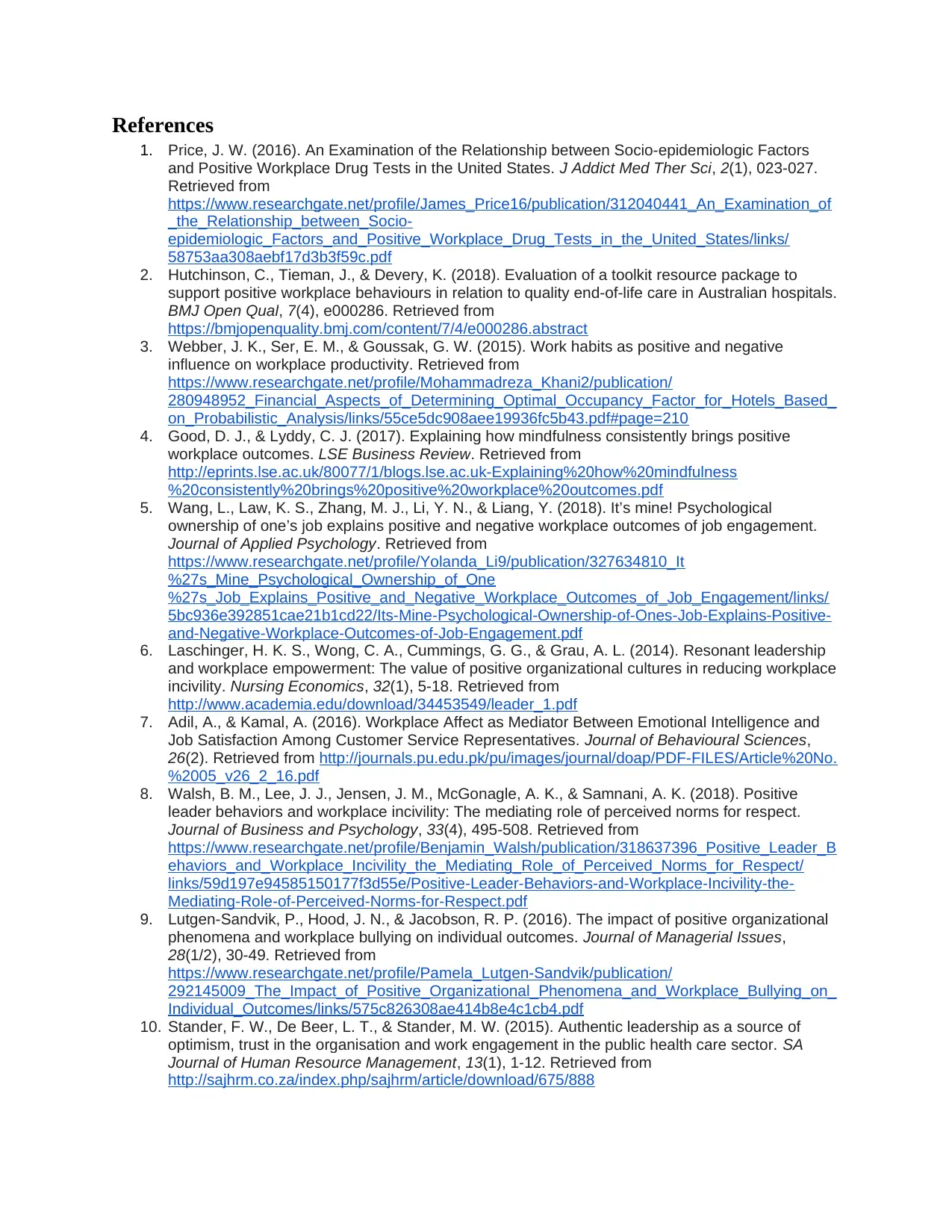
References
1. Price, J. W. (2016). An Examination of the Relationship between Socio-epidemiologic Factors
and Positive Workplace Drug Tests in the United States. J Addict Med Ther Sci, 2(1), 023-027.
Retrieved from
https://www.researchgate.net/profile/James_Price16/publication/312040441_An_Examination_of
_the_Relationship_between_Socio-
epidemiologic_Factors_and_Positive_Workplace_Drug_Tests_in_the_United_States/links/
58753aa308aebf17d3b3f59c.pdf
2. Hutchinson, C., Tieman, J., & Devery, K. (2018). Evaluation of a toolkit resource package to
support positive workplace behaviours in relation to quality end-of-life care in Australian hospitals.
BMJ Open Qual, 7(4), e000286. Retrieved from
https://bmjopenquality.bmj.com/content/7/4/e000286.abstract
3. Webber, J. K., Ser, E. M., & Goussak, G. W. (2015). Work habits as positive and negative
influence on workplace productivity. Retrieved from
https://www.researchgate.net/profile/Mohammadreza_Khani2/publication/
280948952_Financial_Aspects_of_Determining_Optimal_Occupancy_Factor_for_Hotels_Based_
on_Probabilistic_Analysis/links/55ce5dc908aee19936fc5b43.pdf#page=210
4. Good, D. J., & Lyddy, C. J. (2017). Explaining how mindfulness consistently brings positive
workplace outcomes. LSE Business Review. Retrieved from
http://eprints.lse.ac.uk/80077/1/blogs.lse.ac.uk-Explaining%20how%20mindfulness
%20consistently%20brings%20positive%20workplace%20outcomes.pdf
5. Wang, L., Law, K. S., Zhang, M. J., Li, Y. N., & Liang, Y. (2018). It’s mine! Psychological
ownership of one’s job explains positive and negative workplace outcomes of job engagement.
Journal of Applied Psychology. Retrieved from
https://www.researchgate.net/profile/Yolanda_Li9/publication/327634810_It
%27s_Mine_Psychological_Ownership_of_One
%27s_Job_Explains_Positive_and_Negative_Workplace_Outcomes_of_Job_Engagement/links/
5bc936e392851cae21b1cd22/Its-Mine-Psychological-Ownership-of-Ones-Job-Explains-Positive-
and-Negative-Workplace-Outcomes-of-Job-Engagement.pdf
6. Laschinger, H. K. S., Wong, C. A., Cummings, G. G., & Grau, A. L. (2014). Resonant leadership
and workplace empowerment: The value of positive organizational cultures in reducing workplace
incivility. Nursing Economics, 32(1), 5-18. Retrieved from
http://www.academia.edu/download/34453549/leader_1.pdf
7. Adil, A., & Kamal, A. (2016). Workplace Affect as Mediator Between Emotional Intelligence and
Job Satisfaction Among Customer Service Representatives. Journal of Behavioural Sciences,
26(2). Retrieved from http://journals.pu.edu.pk/pu/images/journal/doap/PDF-FILES/Article%20No.
%2005_v26_2_16.pdf
8. Walsh, B. M., Lee, J. J., Jensen, J. M., McGonagle, A. K., & Samnani, A. K. (2018). Positive
leader behaviors and workplace incivility: The mediating role of perceived norms for respect.
Journal of Business and Psychology, 33(4), 495-508. Retrieved from
https://www.researchgate.net/profile/Benjamin_Walsh/publication/318637396_Positive_Leader_B
ehaviors_and_Workplace_Incivility_the_Mediating_Role_of_Perceived_Norms_for_Respect/
links/59d197e94585150177f3d55e/Positive-Leader-Behaviors-and-Workplace-Incivility-the-
Mediating-Role-of-Perceived-Norms-for-Respect.pdf
9. Lutgen-Sandvik, P., Hood, J. N., & Jacobson, R. P. (2016). The impact of positive organizational
phenomena and workplace bullying on individual outcomes. Journal of Managerial Issues,
28(1/2), 30-49. Retrieved from
https://www.researchgate.net/profile/Pamela_Lutgen-Sandvik/publication/
292145009_The_Impact_of_Positive_Organizational_Phenomena_and_Workplace_Bullying_on_
Individual_Outcomes/links/575c826308ae414b8e4c1cb4.pdf
10. Stander, F. W., De Beer, L. T., & Stander, M. W. (2015). Authentic leadership as a source of
optimism, trust in the organisation and work engagement in the public health care sector. SA
Journal of Human Resource Management, 13(1), 1-12. Retrieved from
http://sajhrm.co.za/index.php/sajhrm/article/download/675/888
1. Price, J. W. (2016). An Examination of the Relationship between Socio-epidemiologic Factors
and Positive Workplace Drug Tests in the United States. J Addict Med Ther Sci, 2(1), 023-027.
Retrieved from
https://www.researchgate.net/profile/James_Price16/publication/312040441_An_Examination_of
_the_Relationship_between_Socio-
epidemiologic_Factors_and_Positive_Workplace_Drug_Tests_in_the_United_States/links/
58753aa308aebf17d3b3f59c.pdf
2. Hutchinson, C., Tieman, J., & Devery, K. (2018). Evaluation of a toolkit resource package to
support positive workplace behaviours in relation to quality end-of-life care in Australian hospitals.
BMJ Open Qual, 7(4), e000286. Retrieved from
https://bmjopenquality.bmj.com/content/7/4/e000286.abstract
3. Webber, J. K., Ser, E. M., & Goussak, G. W. (2015). Work habits as positive and negative
influence on workplace productivity. Retrieved from
https://www.researchgate.net/profile/Mohammadreza_Khani2/publication/
280948952_Financial_Aspects_of_Determining_Optimal_Occupancy_Factor_for_Hotels_Based_
on_Probabilistic_Analysis/links/55ce5dc908aee19936fc5b43.pdf#page=210
4. Good, D. J., & Lyddy, C. J. (2017). Explaining how mindfulness consistently brings positive
workplace outcomes. LSE Business Review. Retrieved from
http://eprints.lse.ac.uk/80077/1/blogs.lse.ac.uk-Explaining%20how%20mindfulness
%20consistently%20brings%20positive%20workplace%20outcomes.pdf
5. Wang, L., Law, K. S., Zhang, M. J., Li, Y. N., & Liang, Y. (2018). It’s mine! Psychological
ownership of one’s job explains positive and negative workplace outcomes of job engagement.
Journal of Applied Psychology. Retrieved from
https://www.researchgate.net/profile/Yolanda_Li9/publication/327634810_It
%27s_Mine_Psychological_Ownership_of_One
%27s_Job_Explains_Positive_and_Negative_Workplace_Outcomes_of_Job_Engagement/links/
5bc936e392851cae21b1cd22/Its-Mine-Psychological-Ownership-of-Ones-Job-Explains-Positive-
and-Negative-Workplace-Outcomes-of-Job-Engagement.pdf
6. Laschinger, H. K. S., Wong, C. A., Cummings, G. G., & Grau, A. L. (2014). Resonant leadership
and workplace empowerment: The value of positive organizational cultures in reducing workplace
incivility. Nursing Economics, 32(1), 5-18. Retrieved from
http://www.academia.edu/download/34453549/leader_1.pdf
7. Adil, A., & Kamal, A. (2016). Workplace Affect as Mediator Between Emotional Intelligence and
Job Satisfaction Among Customer Service Representatives. Journal of Behavioural Sciences,
26(2). Retrieved from http://journals.pu.edu.pk/pu/images/journal/doap/PDF-FILES/Article%20No.
%2005_v26_2_16.pdf
8. Walsh, B. M., Lee, J. J., Jensen, J. M., McGonagle, A. K., & Samnani, A. K. (2018). Positive
leader behaviors and workplace incivility: The mediating role of perceived norms for respect.
Journal of Business and Psychology, 33(4), 495-508. Retrieved from
https://www.researchgate.net/profile/Benjamin_Walsh/publication/318637396_Positive_Leader_B
ehaviors_and_Workplace_Incivility_the_Mediating_Role_of_Perceived_Norms_for_Respect/
links/59d197e94585150177f3d55e/Positive-Leader-Behaviors-and-Workplace-Incivility-the-
Mediating-Role-of-Perceived-Norms-for-Respect.pdf
9. Lutgen-Sandvik, P., Hood, J. N., & Jacobson, R. P. (2016). The impact of positive organizational
phenomena and workplace bullying on individual outcomes. Journal of Managerial Issues,
28(1/2), 30-49. Retrieved from
https://www.researchgate.net/profile/Pamela_Lutgen-Sandvik/publication/
292145009_The_Impact_of_Positive_Organizational_Phenomena_and_Workplace_Bullying_on_
Individual_Outcomes/links/575c826308ae414b8e4c1cb4.pdf
10. Stander, F. W., De Beer, L. T., & Stander, M. W. (2015). Authentic leadership as a source of
optimism, trust in the organisation and work engagement in the public health care sector. SA
Journal of Human Resource Management, 13(1), 1-12. Retrieved from
http://sajhrm.co.za/index.php/sajhrm/article/download/675/888
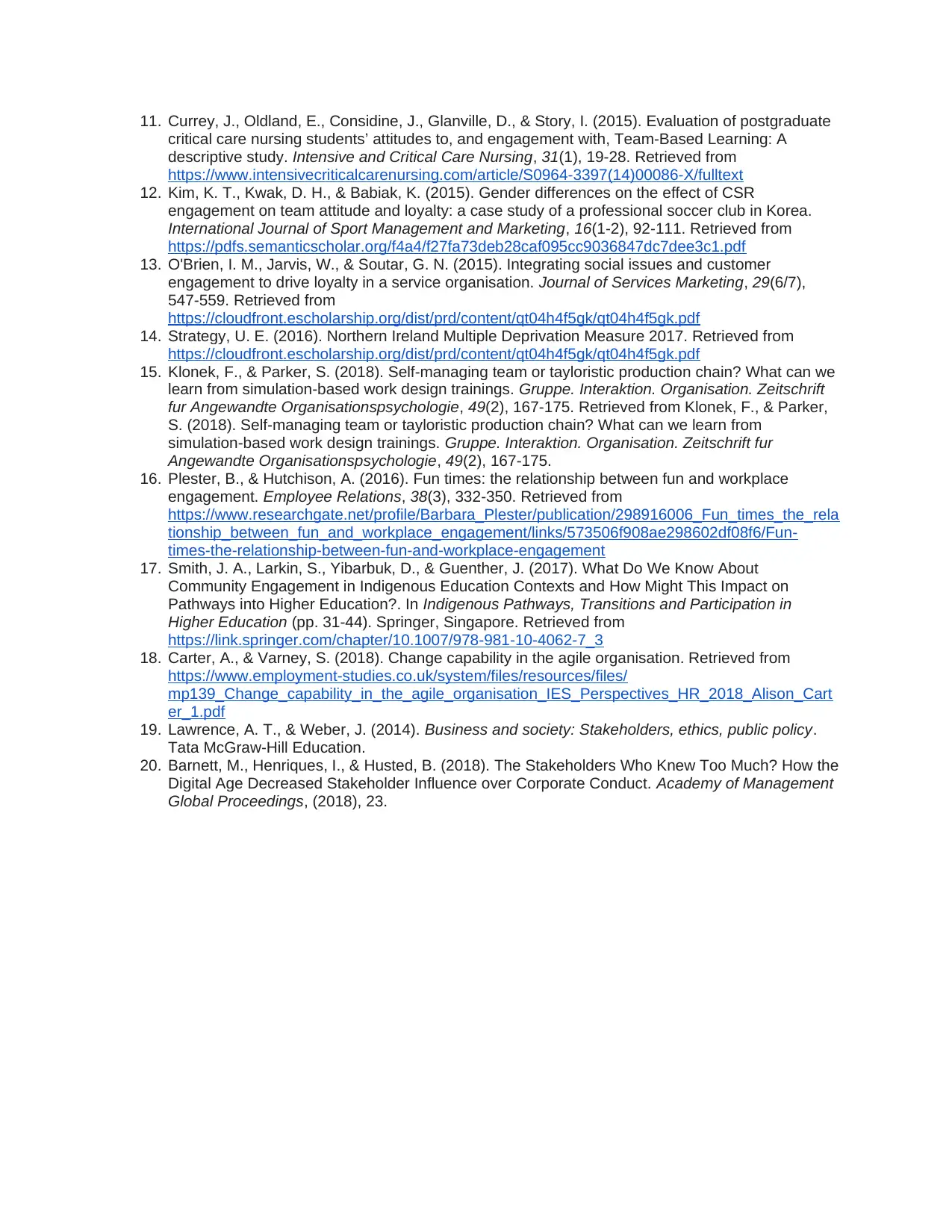
11. Currey, J., Oldland, E., Considine, J., Glanville, D., & Story, I. (2015). Evaluation of postgraduate
critical care nursing students’ attitudes to, and engagement with, Team-Based Learning: A
descriptive study. Intensive and Critical Care Nursing, 31(1), 19-28. Retrieved from
https://www.intensivecriticalcarenursing.com/article/S0964-3397(14)00086-X/fulltext
12. Kim, K. T., Kwak, D. H., & Babiak, K. (2015). Gender differences on the effect of CSR
engagement on team attitude and loyalty: a case study of a professional soccer club in Korea.
International Journal of Sport Management and Marketing, 16(1-2), 92-111. Retrieved from
https://pdfs.semanticscholar.org/f4a4/f27fa73deb28caf095cc9036847dc7dee3c1.pdf
13. O'Brien, I. M., Jarvis, W., & Soutar, G. N. (2015). Integrating social issues and customer
engagement to drive loyalty in a service organisation. Journal of Services Marketing, 29(6/7),
547-559. Retrieved from
https://cloudfront.escholarship.org/dist/prd/content/qt04h4f5gk/qt04h4f5gk.pdf
14. Strategy, U. E. (2016). Northern Ireland Multiple Deprivation Measure 2017. Retrieved from
https://cloudfront.escholarship.org/dist/prd/content/qt04h4f5gk/qt04h4f5gk.pdf
15. Klonek, F., & Parker, S. (2018). Self-managing team or tayloristic production chain? What can we
learn from simulation-based work design trainings. Gruppe. Interaktion. Organisation. Zeitschrift
fur Angewandte Organisationspsychologie, 49(2), 167-175. Retrieved from Klonek, F., & Parker,
S. (2018). Self-managing team or tayloristic production chain? What can we learn from
simulation-based work design trainings. Gruppe. Interaktion. Organisation. Zeitschrift fur
Angewandte Organisationspsychologie, 49(2), 167-175.
16. Plester, B., & Hutchison, A. (2016). Fun times: the relationship between fun and workplace
engagement. Employee Relations, 38(3), 332-350. Retrieved from
https://www.researchgate.net/profile/Barbara_Plester/publication/298916006_Fun_times_the_rela
tionship_between_fun_and_workplace_engagement/links/573506f908ae298602df08f6/Fun-
times-the-relationship-between-fun-and-workplace-engagement
17. Smith, J. A., Larkin, S., Yibarbuk, D., & Guenther, J. (2017). What Do We Know About
Community Engagement in Indigenous Education Contexts and How Might This Impact on
Pathways into Higher Education?. In Indigenous Pathways, Transitions and Participation in
Higher Education (pp. 31-44). Springer, Singapore. Retrieved from
https://link.springer.com/chapter/10.1007/978-981-10-4062-7_3
18. Carter, A., & Varney, S. (2018). Change capability in the agile organisation. Retrieved from
https://www.employment-studies.co.uk/system/files/resources/files/
mp139_Change_capability_in_the_agile_organisation_IES_Perspectives_HR_2018_Alison_Cart
er_1.pdf
19. Lawrence, A. T., & Weber, J. (2014). Business and society: Stakeholders, ethics, public policy.
Tata McGraw-Hill Education.
20. Barnett, M., Henriques, I., & Husted, B. (2018). The Stakeholders Who Knew Too Much? How the
Digital Age Decreased Stakeholder Influence over Corporate Conduct. Academy of Management
Global Proceedings, (2018), 23.
critical care nursing students’ attitudes to, and engagement with, Team-Based Learning: A
descriptive study. Intensive and Critical Care Nursing, 31(1), 19-28. Retrieved from
https://www.intensivecriticalcarenursing.com/article/S0964-3397(14)00086-X/fulltext
12. Kim, K. T., Kwak, D. H., & Babiak, K. (2015). Gender differences on the effect of CSR
engagement on team attitude and loyalty: a case study of a professional soccer club in Korea.
International Journal of Sport Management and Marketing, 16(1-2), 92-111. Retrieved from
https://pdfs.semanticscholar.org/f4a4/f27fa73deb28caf095cc9036847dc7dee3c1.pdf
13. O'Brien, I. M., Jarvis, W., & Soutar, G. N. (2015). Integrating social issues and customer
engagement to drive loyalty in a service organisation. Journal of Services Marketing, 29(6/7),
547-559. Retrieved from
https://cloudfront.escholarship.org/dist/prd/content/qt04h4f5gk/qt04h4f5gk.pdf
14. Strategy, U. E. (2016). Northern Ireland Multiple Deprivation Measure 2017. Retrieved from
https://cloudfront.escholarship.org/dist/prd/content/qt04h4f5gk/qt04h4f5gk.pdf
15. Klonek, F., & Parker, S. (2018). Self-managing team or tayloristic production chain? What can we
learn from simulation-based work design trainings. Gruppe. Interaktion. Organisation. Zeitschrift
fur Angewandte Organisationspsychologie, 49(2), 167-175. Retrieved from Klonek, F., & Parker,
S. (2018). Self-managing team or tayloristic production chain? What can we learn from
simulation-based work design trainings. Gruppe. Interaktion. Organisation. Zeitschrift fur
Angewandte Organisationspsychologie, 49(2), 167-175.
16. Plester, B., & Hutchison, A. (2016). Fun times: the relationship between fun and workplace
engagement. Employee Relations, 38(3), 332-350. Retrieved from
https://www.researchgate.net/profile/Barbara_Plester/publication/298916006_Fun_times_the_rela
tionship_between_fun_and_workplace_engagement/links/573506f908ae298602df08f6/Fun-
times-the-relationship-between-fun-and-workplace-engagement
17. Smith, J. A., Larkin, S., Yibarbuk, D., & Guenther, J. (2017). What Do We Know About
Community Engagement in Indigenous Education Contexts and How Might This Impact on
Pathways into Higher Education?. In Indigenous Pathways, Transitions and Participation in
Higher Education (pp. 31-44). Springer, Singapore. Retrieved from
https://link.springer.com/chapter/10.1007/978-981-10-4062-7_3
18. Carter, A., & Varney, S. (2018). Change capability in the agile organisation. Retrieved from
https://www.employment-studies.co.uk/system/files/resources/files/
mp139_Change_capability_in_the_agile_organisation_IES_Perspectives_HR_2018_Alison_Cart
er_1.pdf
19. Lawrence, A. T., & Weber, J. (2014). Business and society: Stakeholders, ethics, public policy.
Tata McGraw-Hill Education.
20. Barnett, M., Henriques, I., & Husted, B. (2018). The Stakeholders Who Knew Too Much? How the
Digital Age Decreased Stakeholder Influence over Corporate Conduct. Academy of Management
Global Proceedings, (2018), 23.
1 out of 12
Related Documents
Your All-in-One AI-Powered Toolkit for Academic Success.
+13062052269
info@desklib.com
Available 24*7 on WhatsApp / Email
![[object Object]](/_next/static/media/star-bottom.7253800d.svg)
Unlock your academic potential
© 2024 | Zucol Services PVT LTD | All rights reserved.





